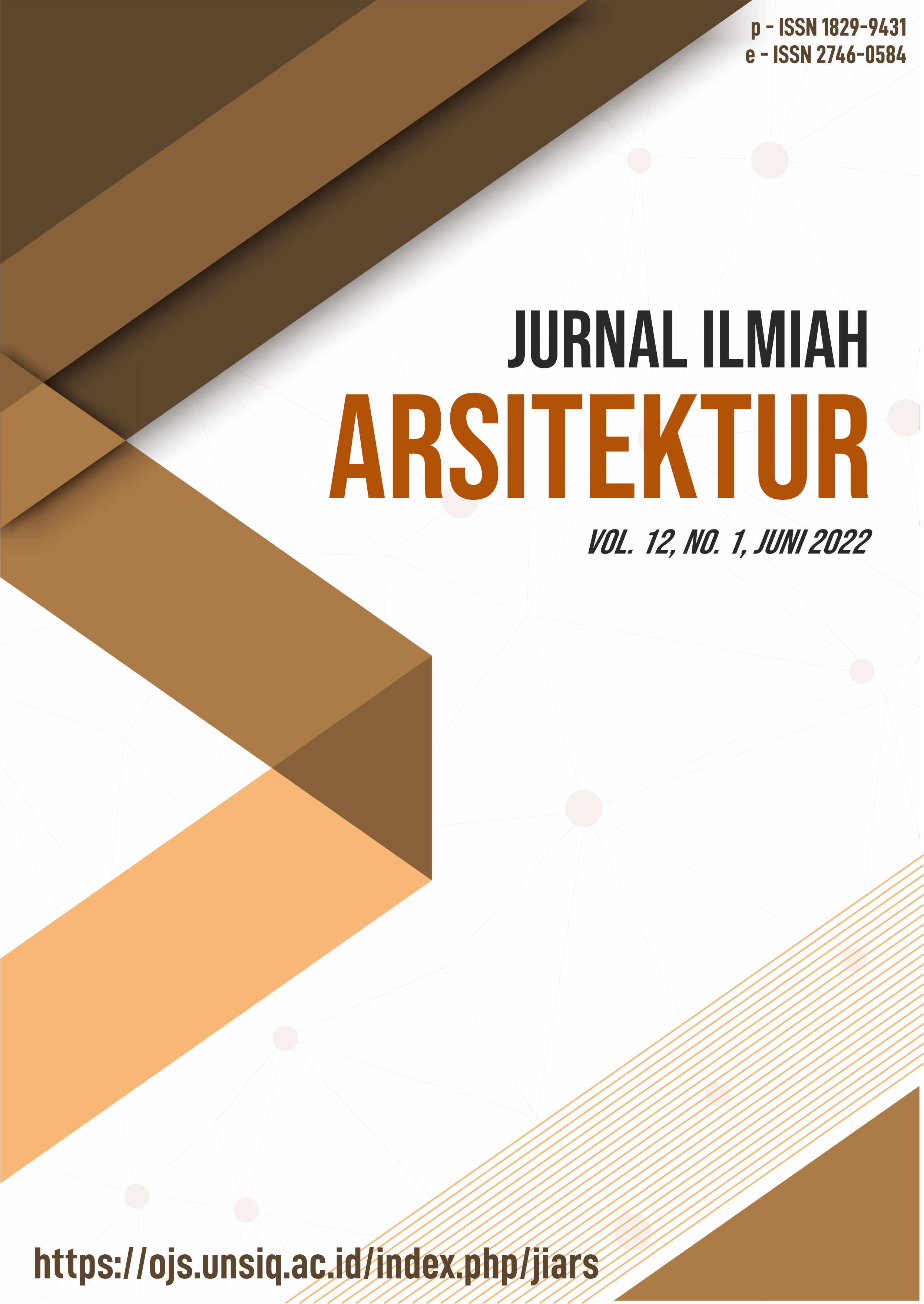VARIABEL TERMAL DAN KANDUNGAN CO2 DI DALAM RUMAH TINGGAL MODERN DI KALIBEBER, WONOSOBO
DOI:
https://doi.org/10.32699/jiars.v12i1.2947Keywords:
Kenyamanan termal, rumah modern, variabel iklimAbstract
Rumah Tinggal modern mempunyai karakteristik yang berbeda dengan rumah tinggal vernakular. Kenyamanan termal menjadi isu yang sering digaungkan pada rumah tinggal modern. Penelitian tentang kenyamanan termal pada rumah tinggal modern penting dilakukan agar diketahui kelemahan rumah tinggal modern. Tujuan penelitian adalah menginvestigasi variabel kenyamanan termal pada rumah modern di daerah pegunungan. Metode yang digunakan adalah metode pengukuran di lapangan. Pengukuran dilakukan pada tiga ruang dengan 5 variabel yaitu suhu udara, suhu globe, kelembaban udara, kecepatan angin dan karbon dioksida (CO2). Hasil penelitian memperlihatkan bahwa rumah tinggal modern mempunyai variabel iklim yang tidak terlalu jauh antara ruang tamu, kamar tidur dan dapur.
References
Belmonte, J. F., R. Barbosa, and Manuela G. Almeida. 2019. “CO 2 Concentrations in a Multifamily Building in Porto, Portugal: Occupants’ Exposure and Differential Performance of Mechanical Ventilation Control Strategies.” Journal of Building Engineering 23 (October 2018): 114–26. https://doi.org/10.1016/j.jobe.2019.01.008.
Hermawan, Hermawan. 2018. “Studi Lapangan Variabel Iklim Rumah Vernakular Pantai Dan Gunung Dalam Menciptakan Kenyamanan Termal Adaptif.” Jurnal Arsitektur ZONASI 1 (2): 96. https://doi.org/10.17509/jaz.v1i2.12467.
Hermawan, Hermawan, and Eddy Prianto. 2018. “Thermal Evaluation for Exposed Stone House with Quantitative and Qualitative Approach in Mountainous Area, Wonosobo, Indonesia.” IOP Conference Series: Earth and Environmental Science 99 (1). https://doi.org/10.1088/1755-1315/99/1/012017.
Hermawan, Hermawan, Eddy Prianto, and Erni Setyowati. 2018. “Analisa Perbandingan Suhu Permukaan Dinding Rumah Vernakular Pantai Dan Gunung.” Jurnal Arsitektur ARCADE 2 (3): 149. https://doi.org/10.31848/arcade.v2i3.77.
———. 2019. “Indoor Temperature Prediction of the Houses With Exposed Stones in Tropical Mountain Regions During Four Periods of Different Seasons.” International Journal of Civil Engineering and Technology (IJCIET) 10 (5): 604–12. http://www.iaeme.com/IJCIET/index.asp604http://www.iaeme.com/ijmet/issues.asp?JType=IJCIET&VType=10&IType=5http://www.iaeme.com/IJCIET/issues.asp?JType=IJCIET&VType=10&IType=5http://www.iaeme.com/IJCIET/index.asp605.
Hermawan, Hermawan, and Jozef Švajlenka. 2021. “The Connection between Architectural Elements and Adaptive Thermal Comfort of Tropical Vernacular Houses in Mountain and Beach Locations.” Energies 14 (21). https://doi.org/10.3390/en14217427.
———. 2022. “Building Envelope and the Outdoor Microclimate Variable of Vernacular Houses: Analysis on the Environmental Elements in Tropical Coastal and Mountain Areas of Indonesia.” Sustainability 14 (3): 1818. https://doi.org/10.3390/su14031818.
Hermawan, Eddy Prianto, and Erni Setyowati. 2014. “Evaluasi Termal Ruang Luar Desa Wisata Dieng Wonosobo.” Jurnal Penelitian Dan Pengabdian Kepada Masyarakat UNSIQ, no. 2: 115–22.
Hermawan, Eddy Prianto, Erni Setyowati, and Sunaryo. 2017. “The Comparison of Vernacular Residences’ Thermal Comfort in Coastal with That in Mountainous Regions of Tropical Areas.” AIP Conference Proceedings 1903. https://doi.org/10.1063/1.5011589.
———. 2019. “The Thermal Condition and Comfort Temperature of Traditional Residential Houses Located in Mountainous Tropical Areas: An Adaptive Field Study Approach.” International Journal on Advanced Science, Engineering and Information Technology 9 (6): 1833–40. https://doi.org/10.18517/ijaseit.9.6.3560.
Hermawan, Josef Prijotomo, and Yohanes Basuki Dwisusanto. 2020. “The Geni Tradition as the Center of the Shelter for Plateau Settlements.” Ecology, Environment and Conservation 26 (1): 34–38.
Hermawan, Josef Prijotomo, Yohanes Basuki Dwisusanto, and Nasyiin Faqih. 2022. “Changing Meanings of Hearths in Vernacular Highland Houses in Indonesia.” ISVS E-Journal 9 (2): 130–45.
Li, En, Luyao Chen, Tianqi Zhang, Jiangkun Zhu, and Ren Hou. 2022. “A Nearly Zero Energy Building Design Method Based on Architecture Form Design for High Solar Exposure Areas in China’s Severe Cold and Cold Regions.” Journal of Building Engineering 45 (100). https://doi.org/10.1016/j.jobe.2021.103641.
Švajlenka, Jozef, Mária Kozlovská, and Daria Mokrenko. 2021. “Mgo-Based Board Materials for Dry Construction Are a Tool for More Sustainable Constructions—Literature Study and Thermal Analysis of Different Wall Compositions.” Sustainability (Switzerland) 13 (21). https://doi.org/10.3390/su132112193.


